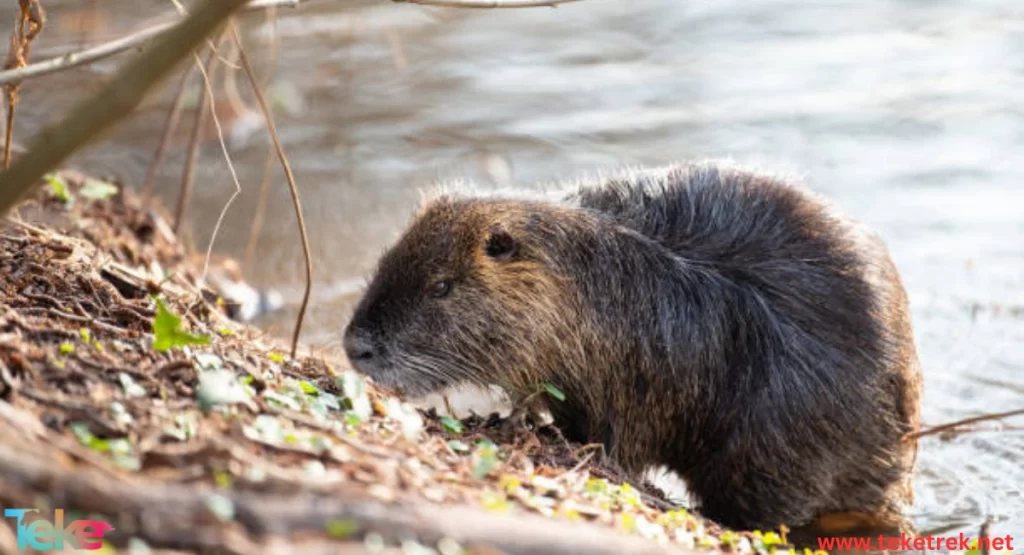The river rat belongs to the Mustelidae family. It is classified as a large rodent within the order Rodentia.
Let’s learn more about it from teketrek.

The River Rat specifications:
The fur: River rats have long, soft fur covering their bodies, which varies in color between gray, brown, and yellow.
Length: River rat can grow up to 50 cm in length.
Weigh: The weigh between 4 to 7 kg.
Head: Their eyes, nose, and ears are located on the top of their heads for breathing, seeing, and hearing while swimming.
Claws: Each of their limbs has toes with claws.
Legs: Its legs help it while walking and use it to put food in its mouth.
Whiskers: They have long sensory whiskers.
What do River Rats feed on
River rats primarily feed on aquatic and semi-aquatic plants, as well as vegetables, roots, and mollusks.
They have been known to consume over 227 plant species in their diet.
Habitat of River Rats:
River Rats can be found in various regions around the world, originating from South America, now widely distributed, but it abandoned its homeland.
The Turkish reserve, which is located in the state of Agri, east of the country.
There are also worldwide, Scotland and Asia.
The River Rat is found mainly in slow-flowing rivers and lakes.
River Rat location must have water inlets to give the animals a safe escape route in case of danger.
They also live on grassy banks along slow-moving rivers, streams, ponds and canals, in addition to swamps and uplands.
Reproduction stages of River Rats:
River Rats have adapted to survive in various climatic conditions, with temperatures ranging from 45 degrees Celsius in summer and 10 degrees Celsius below zero in the winter.
Since river rats live in groups, this means that the dominant male courtes the dominant female and mates with her several times.
Mating occurs in late February, with pregnancies starting in March.
The gestation period lasts from 128 to 132 days, resulting in the birth of 4 to 9 pups.
Female Nurse their young for 7 to 8 weeks on land or in water.
They carry their pups in their mouths if water levels rise, lifting them above the water.
Sexual maturity in river rat is usually reached by the second year of age.
Facts about the river rat:
· River rat are social animals that live in groups, with the female being the dominant member of the group.
· The young females remain within the group, while the young males are eventually driven out.
· These animals are hunted due to their threat to large agriculture, and also for their fur and meat.
· The male river rat is smaller than the female rat and has 6 pairs of nipples on each side of the abdomen.
· They are nocturnal animals, active during dusk and night, taking refuge in burrows with entrances around 20 cm wide.
· River rats are excellent swimmers and spend most of their time in the water.
· The dominant female in the group gives birth multiple times, with a preference for giving birth to both males and females. The less dominant females have fewer opportunities for reproduction.
· There are two scent glands that secrete what gives off scent.

FAQs about a river rat:
- What is another name for a river rat
It is commonly known as the Nutria or River Rat.
- How big are river rats?
It weighs between 4 to 9 kg. - ?Is a River Rat a rat
Nutria isn’t really rat but it looks like rat with its long reddish teeth, twitchy whiskers and slinky tail.
- ?Are River Rat (Nutria) friendly
They are not always great neighbors
Nutria sometimes will become aggressive.
- ?What is the biggest river rat in the world
Capybara is the biggest river rat in the world.
- ?Will a Nutria bite
Nutria have known to be territorial and aggressive when caught or cornered, they will bite and attack humans and dogs when threatened.
In conclusion, river rats play a crucial role in maintaining ecological balance by feeding on various aquatic plants and herbs. We hope that we have provided you with valuable information and amazing facts about river rats, which are considered large rodents.
References:
*Wikipedia.org





